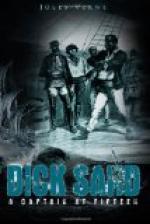“Ah, now, but those are giraffes!” cried Dick Sand, without otherwise replying to Harris’s observation.
“Giraffes!” repeated Jack, standing up on the horse’s saddle. “Where are they, the large beasts?”
“Giraffes!” replied Mrs. Weldon. “You are mistaken, my dear Dick. There are no giraffes in America.”
“Indeed,” said Harris, who appeared rather surprised, “there cannot be any giraffes in this country.”
“What, then?” said Dick Sand.
“I really do not know what to think,” replied Harris. “Have not your eyes deceived you, my young friend, and are not those animals more likely to be ostriches?”
“Ostriches!” repeated Dick Sand and Mrs. Weldon, looking at each other in great surprise.
“Yes, only ostriches,” repeated Harris.
“But ostriches are birds,” returned Dick Sand, “and consequently they have only two feet.”
“Well,” replied Harris, “I indeed thought I saw that those animals, which have just made off so rapidly, were bipeds.”
“Bipeds!” replied the novice.
“Indeed it seemed to me that I saw animals with four legs,” then said Mrs. Weldon.
“I also,” added old Tom; then Bat, Acteon, and Austin confirmed those words.
“Ostriches with four legs!” cried Harris, with a burst of laughter. “That would be ridiculous!”
“So,” returned Dick Sand, “we have believed they were giraffes, and not ostriches.”
“No, my young friend, no,” said Harris. “You have certainly seen badly. That is explained by the rapidity with which those animals have flown away. Besides, it has happened more than once that hunters have been deceived like you, and in the best faith in the world.”
What the American said was very plausible. Between an ostrich of great height and a giraffe of medium height, seen at a certain distance, it is easy to make a mistake. If it were a question of a beak or a nose, both are none the less joined to the end of a long neck turned backward, and, strictly speaking, it may be said that an ostrich is only a half giraffe. It only needs the hind legs. Then, this biped and this quadruped, passing rapidly, on a sudden may, very properly, be taken one for the other.
Besides, the best proof that Mrs. Weldon and the others were mistaken was that there are no giraffes in America.
Dick Sand then made this reflection:
“But I believed that ostriches were not met with in the New World any more than giraffes.”
“Yes, my young friend,” replied Harris; “and, indeed, South America possesses a peculiar species. To this species belongs the ‘nandon,’ which you have just seen.”
Harris spoke the truth. The “nandon” is a long-legged bird, rather common in the plains of South America, and its flesh, when it is young, is good to eat.
This strong animal, whose height sometimes exceeds two meters, has a straight beak; wings long, and formed of tufted feathers of a bluish shade; feet formed of three claws, furnished with nails—which essentially distinguishes it from the ostriches of Africa.




